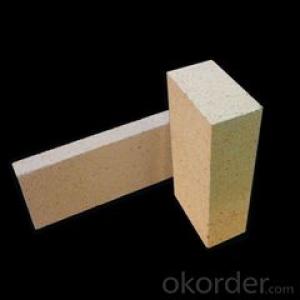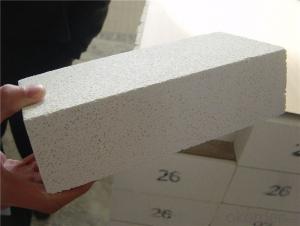Insulating Fire Brick - Mullite Insulation Brick
- Loading Port:
- Shanghai
- Payment Terms:
- TT OR LC
- Min Order Qty:
- 1 m.t.
- Supply Capability:
- 10000 m.t./month
OKorder Service Pledge
OKorder Financial Service
You Might Also Like
Thermal Insulation Fire Clay Brick
Refractory brick is a refractory material used in lining furnaces, kilns, fireboxes, and fireplaces.
We provide high quality Refractory Fire Bricks that are used on wide range in the various industries like Cement, Glass and Steel. Refractory Fire Bricks are provided as per the quantity and specifications required by the customers. We provide an extensive range of Refractory Fire Bricks at reasonable prices that depend upon the quantity ordered.
Application
Insulating Fire Brick are used for the lining of converter, alternating current arc furnace, direct Current arc furnace and the ladle slag line, etc.
Company Advantage
(1)Long Insulating Fire Brick manufacture history: 25 years manufacturer
(2)Advanced equipment and good service
(3)Diversification of production standards: ISO ANSI FEPA JIS ASTM
(4)Flexible payment: T/T L/C D/P D/A
(5)Professional marketing team and after-sale service
Insulating Fire Brick main feature:

Equipment
1 unit of Ceramic Abrasive (SG Abrasive) pilot production line
2 units of Compact grain Abrasive pilot production lines
1 unit of high-end coated abrasives (abrasive cloth) production line
3 large flexible crushing and sieving lines for grit production lines
6 units of 5000KVA-10000KVA dumping type electric arc furnaces for Brown Fused Alumina fusion
FAQs
Q1 What’s the transport method?
A1 FCL delivery goods with wooden pallet or wooden case by sea; If LCL delivery, must with wooden case; Sometimes need open top, flat rack or bulk cargo.
Q2 What’s the required payment term?
A2 Generally 30% TT as the prepayment, 70% TT before delivery. If need, 100% Irrevocable Letter of Credit or negotiation.
Q3 Which country are our products exported to?
A3 Apart from entire Chinese market, the US, Russia, Japan, Korea, Australia and some Southeast Asian Nations.


- Q: Can insulating fire bricks be cut to custom sizes?
- Yes, insulating fire bricks can be cut to custom sizes. These bricks are made from lightweight materials such as ceramic fibers, which make them easier to shape and cut according to specific requirements.
- Q: Can insulating fire bricks be used in the construction of boilers?
- Yes, insulating fire bricks can be used in the construction of boilers. Insulating fire bricks are made from lightweight materials that have high thermal insulation properties, making them suitable for use in high-temperature applications such as boilers. These bricks help to reduce heat loss and improve energy efficiency by preventing the escape of heat from the boiler. Additionally, they have excellent resistance to thermal shock and can withstand extreme temperatures, making them a reliable choice for boiler construction.
- Q: Are insulating fire bricks resistant to flame impingement?
- Yes, insulating fire bricks are resistant to flame impingement.
- Q: Can insulating fire bricks be used in chimneys and flues?
- Insulating fire bricks are designed specifically for high-temperature usage and are commonly employed in industrial settings, furnaces, and kilns. While they possess exceptional insulating properties, they may not be the optimal choice for chimneys and flues in residential or commercial buildings. The primary reason for this is that insulating fire bricks lack the durability and heat resistance found in other materials specifically designed for chimney and flue construction. They have the potential to crack or break when subjected to the extreme heat and rapid temperature fluctuations that occur in chimneys. Moreover, these bricks are not typically engineered to withstand the corrosive effects of flue gases, which can result in their degradation over time. When dealing with chimneys and flues, it is generally recommended to utilize materials like clay flue liners, stainless steel, or refractory bricks that are specifically manufactured for these purposes. These materials are better equipped to handle the elevated temperatures, corrosive gases, and rapid thermal expansion and contraction that are inherent to chimneys. It is crucial to consult a professional chimney or flue specialist who can provide guidance on the suitable materials to employ based on the specific requirements and conditions of your chimney or flue system.
- Q: Are insulating fire bricks resistant to thermal spalling?
- Yes, insulating fire bricks are resistant to thermal spalling.
- Q: Can insulating fire bricks be used in cement kilns?
- Yes, insulating fire bricks can be used in cement kilns. These bricks have high thermal insulation properties, which help in reducing heat loss and increasing energy efficiency in the kiln. Additionally, they can withstand high temperatures and provide effective insulation, making them suitable for use in cement kilns.
- Q: How does an insulating fire brick work?
- Insulating fire bricks, which are also referred to as refractory bricks, serve as thermal barriers in various industrial applications and are designed to withstand high temperatures. These bricks are made from refractory materials that possess low thermal conductivity, indicating their poor heat conduction abilities. The primary mechanism employed by insulating fire bricks revolves around their capability to hinder and slow down heat transfer. Unlike regular bricks or concrete, insulating fire bricks possess a significant number of air pockets within their structure, which act as insulators. These air pockets effectively obstruct the movement of thermal energy, preventing heat transfer. When exposed to high temperatures, insulating fire bricks absorb minimal amounts of heat due to their low thermal conductivity. Rather than conducting heat through the brick, the energy is either absorbed or reflected by the air pockets present in the brick's structure. As a result, heat is unable to permeate to the other side of the brick, effectively creating a thermal barrier. Moreover, the refractory materials utilized in insulating fire bricks inherently possess resistance against thermal shock, enabling them to endure rapid temperature changes without cracking or breaking. This quality makes them exceptionally suitable for applications where extreme temperature fluctuations occur frequently. Insulating fire bricks find extensive usage in industries such as metallurgy, ceramics, glass manufacturing, and kiln construction. They are primarily used to line furnaces, kilns, and other equipment operating at high temperatures. By effectively reducing heat transfer, these bricks contribute to enhancing energy efficiency, minimizing heat loss, and safeguarding surrounding materials and structures from the extreme levels of heat. In summary, the operational principle of an insulating fire brick lies in its ability to minimize heat transfer by virtue of its low thermal conductivity and air pocket structure. By establishing a thermal barrier, these bricks fulfill a critical role in providing insulation, protecting against heat loss, and ensuring the smooth functioning of high-temperature processes.
- Q: Can insulating fire bricks be used in the construction of foundry molds?
- Yes, insulating fire bricks can be used in the construction of foundry molds. Insulating fire bricks are designed to withstand high temperatures and provide excellent thermal insulation properties, which make them suitable for use in foundry molds. These bricks help to maintain a consistent temperature within the mold, ensuring efficient and effective casting processes.
- Q: Do insulating fire bricks have a high electrical resistivity?
- Yes, insulating fire bricks generally have a high electrical resistivity. This is because these bricks are specifically designed to have low thermal conductivity and high thermal resistance, which also translates into high electrical resistivity. The insulating materials used in these bricks, such as alumina, silica, and other refractory materials, have inherently high electrical resistivity. Additionally, the manufacturing processes often involve the addition of insulating additives, further enhancing the electrical resistivity of the fire bricks. As a result, insulating fire bricks are effective in reducing heat transfer and maintaining high temperatures in various industrial applications, such as kilns, furnaces, and thermal insulation systems.
- Q: What is the average density of insulating fire bricks?
- The average density of insulating fire bricks typically ranges from 0.6 to 1.2 grams per cubic centimeter.
Send your message to us
Insulating Fire Brick - Mullite Insulation Brick
- Loading Port:
- Shanghai
- Payment Terms:
- TT OR LC
- Min Order Qty:
- 1 m.t.
- Supply Capability:
- 10000 m.t./month
OKorder Service Pledge
OKorder Financial Service
Similar products
Hot products
Hot Searches
Related keywords




























